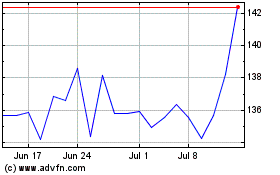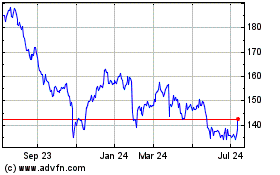UPS Profit Tops Forecasts; Upbeat Outlook Given for Year -- Update
February 02 2016 - 2:39PM
Dow Jones News
By Laura Stevens
United Parcel Service Inc. reported profits nearly tripled in
the fourth quarter, exceeding Wall Street expectations, as more
customers shipped via air and higher prices and cost-saving efforts
paid off during its all-important holiday season.
The delivery giant also gave an upbeat earnings forecast for
2016 on strong e-commerce demand even as industrial production
falls in key countries amid a weaker global economic outlook.
UPS set out this past holiday to prove to investors it can
balance costs with late-year surges in e-commerce
volume--deliveries to consumers accounted for about 60% of all U.S.
deliveries in December, up from about 45% in the third quarter.
Despite peak holiday volumes coming in slightly under forecast,
UPS posted earnings of $1.33 billion, or $1.48 a share, up from
$453 million, or 49 cents a share, a year earlier.
UPS missed earnings expectations the previous two holidays,
first because it wasn't able to deliver all its packages on time,
then because it over prepared for volume that came in unevenly.
Both those years it overspent by $200 million.
The company said it lowered costs by shifting more than 35% of
its SurePost package deliveries--typically delivered to the door by
the U.S. Postal Service--back into its own network to increase the
number of packages a driver delivers at each stop. Other
initiatives also started to pay off, including driver-routing
software Orion, now 70% installed, and the introduction of Access
Point locations where customers can pick up their packages.
Just a 10% increase in packages per stop creates about $200
million in operating profit improvement, Chief Commercial Officer
Alan Gershenhorn told analysts Tuesday on an earnings call. "The
things that we're doing to our network now are going to enable us
to handle bigger and bigger peaks," he added.
UPS said it hired between 90,000 and 95,000 seasonal workers, as
expected, but brought them on later, reducing hours by 8%. Its
summer acquisition of Coyote Logistics also lowered outside
transportation costs.
Holiday volume came in lower than UPS expected, as it delivered
612 million packages between Black Friday and New Year's Eve, down
from the expected 630 million. Chief Financial Officer Richard
Peretz in an interview attributed that in part to more holiday
returns being shipped later than expected, in January.
Ground package volume also grew below expectations, in part due
to slowing industrial production, as well as UPS's decision to drop
some low-yield customers. An increase in air volumes helped make up
for that, as its U.S. deferred air product grew nearly 15%, while
next-day overnight products were up 10%.
Retailers were using air to ship packages farther and faster,
Mr. Peretz said, as more retailers aim for two-day delivery. Air
pricing has also become more competitive with ground due to the
lower price of fuel.
Industry analysts attributed part of the shift to consumers
ordering more online later in the season, requiring retailers to
ship it by air for on-time delivery.
Amazon.com Inc.'s delivery ambitions have weighed on UPS's stock
prices in recent weeks, after reports the e-commerce giant was
leasing its own cargo aircraft. UPS Chief Executive David Abney
said nothing he has seen points to any substantial effect on
pricing in the market
Mr. Abney told analysts that Amazon is a good customer and the
two companies have a mutually beneficial relationship. "We do add
capacity, and for large customers such as Amazon we do it, though
we ensure we have the proper economic return," he said.
UPS's revenue edged up 1% to $16.05 billion in the fourth
quarter. Excluding currency effects, revenue would have risen
2.4%.
Adjusted earnings were $1.57 a share. Analysts had expected
earnings of $1.42 a share on revenue of $16.28 billion, according
to Thomson Reuters.
Despite concerns about worsening macroeconomic conditions, the
company gave an optimistic 2016 earnings forecast of $5.70 to $5.90
a share, a 5% to 9% increase over adjusted 2015 results. Analysts
were expecting $5.73 a share.
"Our guidance range is really set at a high and a low, because
we realize that the macro environment is not clear. But as
important is what we're doing inside UPS," including adjusting
international routes and modernizing package-sorting hubs, Mr.
Peretz said in the interview.
UPS share prices remained largely unchanged, flat at $94.42 in
early afternoon trading.
Anne Steele contributed to this article.
Write to Laura Stevens at laura.stevens@wsj.com
(END) Dow Jones Newswires
February 02, 2016 14:24 ET (19:24 GMT)
Copyright (c) 2016 Dow Jones & Company, Inc.
United Parcel Service (NYSE:UPS)
Historical Stock Chart
From Mar 2024 to Apr 2024

United Parcel Service (NYSE:UPS)
Historical Stock Chart
From Apr 2023 to Apr 2024
